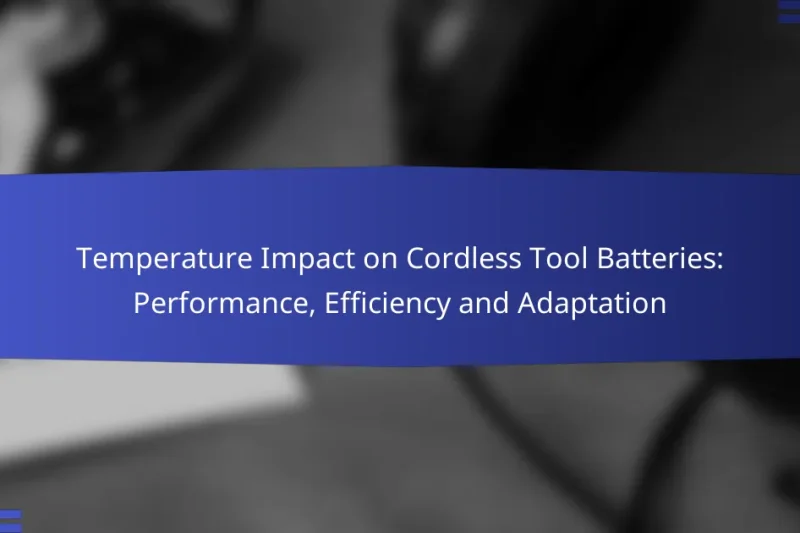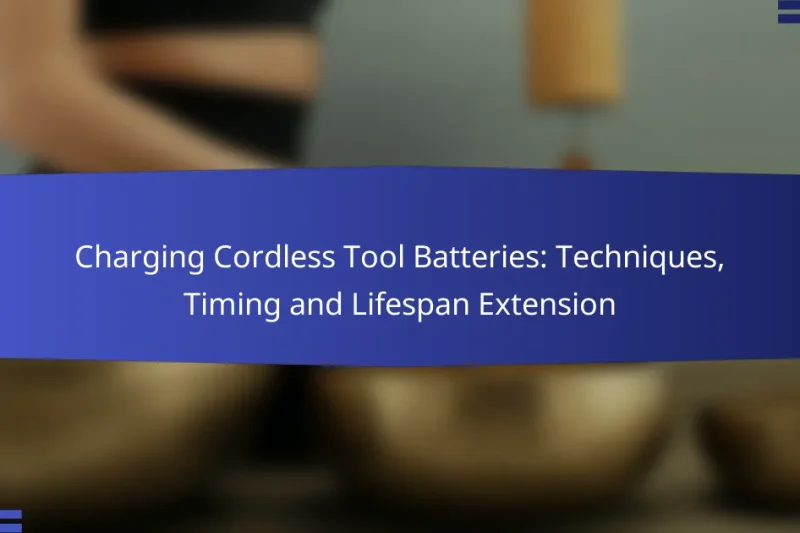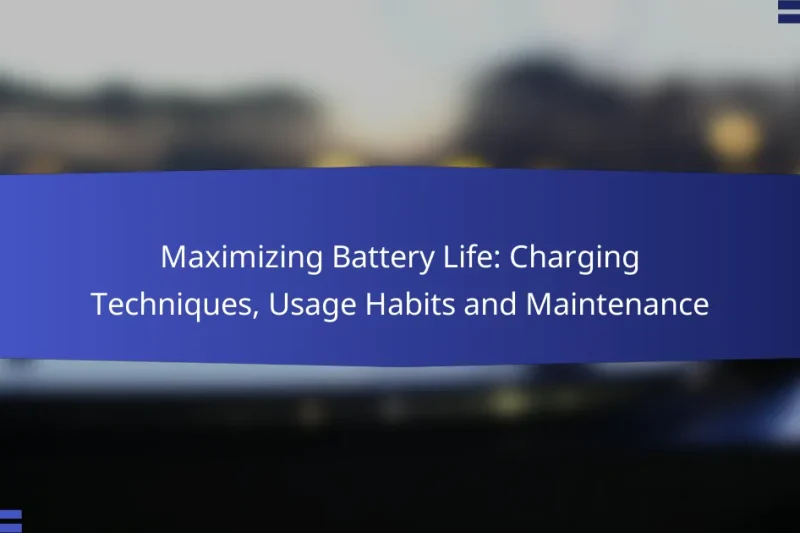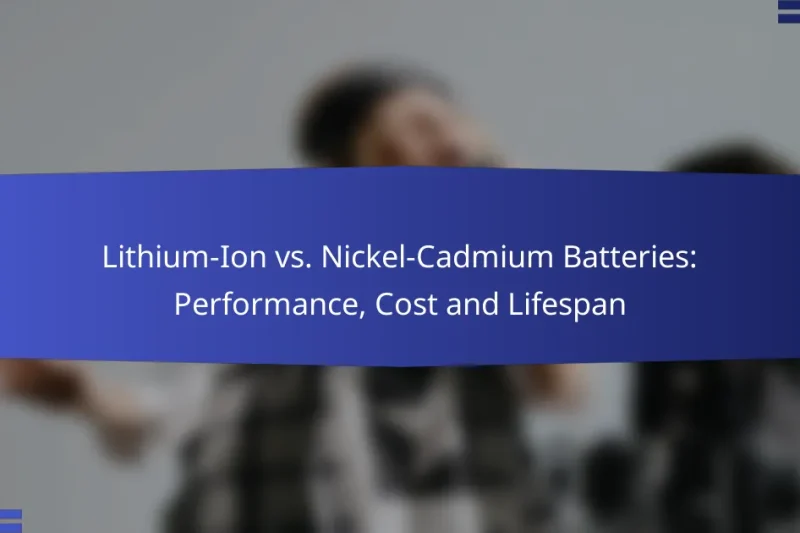When it comes to battery replacement for electric vehicles (EVs), there are several options to consider, … Battery Replacement Options: Cost Savings, Longevity and CompatibilityRead more
Cordless Tools: Battery Life and Performance
Cordless tools have revolutionized the way we approach projects, offering convenience and flexibility without the hassle of cords. However, to ensure optimal battery life and performance, it’s essential to understand key factors such as battery capacity, motor efficiency, and proper maintenance practices. By selecting the right tools and implementing effective usage strategies, users can enhance their experience and achieve better results.
Temperature Impact on Cordless Tool Batteries: Performance, Efficiency and Adaptation
Temperature plays a crucial role in the performance and efficiency of cordless tool batteries, directly influencing … Temperature Impact on Cordless Tool Batteries: Performance, Efficiency and AdaptationRead more
Charging Cordless Tool Batteries: Techniques, Timing and Lifespan Extension
Charging cordless tool batteries requires careful attention to technique and timing to ensure optimal performance and … Charging Cordless Tool Batteries: Techniques, Timing and Lifespan ExtensionRead more
Choosing the Right Battery: Usage Frequency, Compatibility and Performance
Choosing the right battery involves understanding your usage frequency, compatibility with your device, and performance characteristics. … Choosing the Right Battery: Usage Frequency, Compatibility and PerformanceRead more
Maximizing Battery Life: Charging Techniques, Usage Habits and Maintenance
Maximizing battery life is essential for ensuring your devices remain functional throughout the day. By implementing … Maximizing Battery Life: Charging Techniques, Usage Habits and MaintenanceRead more
Battery Capacity Ratings: Understanding, Implications and Performance
Battery capacity ratings are crucial for understanding how long a device can function before requiring a … Battery Capacity Ratings: Understanding, Implications and PerformanceRead more
Lithium-Ion vs. Nickel-Cadmium Batteries: Performance, Cost and Lifespan
When comparing Lithium-Ion and Nickel-Cadmium batteries, Lithium-Ion emerges as the superior choice for performance, longevity, and … Lithium-Ion vs. Nickel-Cadmium Batteries: Performance, Cost and LifespanRead more
How to maximize cordless tool battery life?
To maximize cordless tool battery life, focus on proper battery maintenance and usage practices. Implementing a few key strategies can significantly extend the lifespan and performance of your tools.
Use high-quality lithium-ion batteries
Investing in high-quality lithium-ion batteries is crucial for enhancing battery life. These batteries typically offer better energy density, longer run times, and reduced self-discharge rates compared to lower-quality alternatives. Always choose batteries from reputable brands that meet industry standards.
Regularly maintain and clean tools
Regular maintenance and cleaning of cordless tools can prevent battery drain and ensure optimal performance. Remove dust and debris from battery contacts and tool components to maintain good electrical connections. Periodically check for wear and tear, and replace any damaged parts promptly.
Avoid extreme temperatures
Extreme temperatures can severely affect battery performance and longevity. Avoid exposing cordless tools and batteries to high heat or freezing conditions, as this can lead to reduced capacity and potential damage. Store batteries in a cool, dry place, ideally within a temperature range of 10°C to 25°C (50°F to 77°F).
Charge batteries correctly
Charging batteries correctly is essential for maximizing their lifespan. Always use the charger specified by the manufacturer, as incorrect chargers can lead to overheating or overcharging. Aim to charge batteries when they reach around 20% capacity and avoid letting them fully discharge regularly.
Limit heavy usage
Limiting heavy usage can help preserve battery life during demanding tasks. If possible, alternate between multiple batteries to prevent overheating and excessive drain on a single battery. For prolonged tasks, consider taking breaks to allow the battery to cool down and recover.
What factors affect cordless tool performance?
Several key factors influence the performance of cordless tools, including battery capacity, motor efficiency, tool weight, and the type of work being performed. Understanding these elements can help users select the right tools for their specific needs and optimize their usage.
Battery capacity and voltage
Battery capacity, measured in amp-hours (Ah), and voltage significantly impact cordless tool performance. A higher capacity means longer run times, while increased voltage typically translates to more power. For example, a 5Ah battery at 18V will generally provide more sustained energy than a 2Ah battery at the same voltage.
When choosing batteries, consider the tool’s requirements and the nature of your tasks. For heavy-duty applications, opt for batteries with higher capacity and voltage to ensure consistent performance.
Motor efficiency and design
The efficiency and design of a tool’s motor directly affect its performance and battery life. Brushless motors, for instance, are more efficient than brushed motors, leading to longer run times and less heat generation. This efficiency can result in up to 50% longer battery life under similar conditions.
When selecting a cordless tool, look for models with advanced motor technology to maximize performance and minimize energy consumption. Tools designed for specific tasks often have optimized motors that enhance their effectiveness.
Tool weight and ergonomics
The weight and ergonomic design of cordless tools can influence user comfort and control, impacting overall performance. Lighter tools are generally easier to handle, reducing fatigue during extended use. Ergonomically designed grips can enhance user comfort and precision, especially in repetitive tasks.
When choosing a cordless tool, consider its weight and how it feels in your hand. A well-balanced tool can improve control and accuracy, making it more effective for various applications.
Type of work being performed
The type of work you plan to do with cordless tools plays a crucial role in their performance. For instance, tasks requiring high torque, like drilling into dense materials, may demand tools with higher voltage and capacity. Conversely, lighter tasks like assembling furniture may not require as much power.
Assess the specific demands of your projects to select the appropriate cordless tools. Understanding the requirements of your tasks will help you choose tools that offer the best performance and efficiency for your needs.
Which brands offer the best battery performance?
Brands like DeWalt, Milwaukee, Makita, and Bosch are known for their superior battery performance in cordless tools. Each brand has unique technologies and features that enhance battery life and efficiency, making them popular choices among professionals and DIY enthusiasts.
DeWalt cordless tools
DeWalt is recognized for its robust battery technology, particularly the FlexVolt system, which allows tools to switch between 20V and 60V, optimizing power and runtime. Their batteries typically offer long-lasting performance, often exceeding 30% more runtime compared to competitors.
When selecting DeWalt tools, consider the specific battery capacity, which ranges from 2Ah to 12Ah. Higher amp-hour (Ah) ratings generally provide longer usage times, making them ideal for heavy-duty applications.
Milwaukee cordless tools
Milwaukee’s M18 and M12 systems are designed for high performance and durability, featuring RedLithium battery technology that delivers more work per charge. Users often report significant improvements in runtime, with some batteries lasting up to 50% longer than previous models.
For optimal performance, choose Milwaukee tools with the highest Ah ratings for demanding tasks. Their batteries are also equipped with built-in temperature management systems to prevent overheating, ensuring consistent performance.
Makita cordless tools
Makita is known for its efficient battery systems, particularly the LXT line, which utilizes lithium-ion technology for faster charging and longer life. Their batteries are designed to withstand extreme conditions, making them suitable for both indoor and outdoor use.
When considering Makita tools, look for models with 4Ah or higher batteries for extended runtime. Their rapid charging capabilities can recharge batteries in under an hour, minimizing downtime on the job.
Bosch cordless tools
Bosch offers a variety of cordless tools with their Power for All battery system, which allows compatibility across multiple tool categories. Their batteries are engineered for longevity, often providing consistent power output throughout the charge cycle.
For best results with Bosch tools, opt for batteries with higher Ah ratings, as they typically provide longer usage times. Additionally, Bosch’s innovative battery management systems help prolong battery life by preventing over-discharge and overheating.
How to choose the right cordless tool for your needs?
Selecting the right cordless tool involves understanding your specific requirements, including battery life, compatibility with other tools, and available support options. By assessing these factors, you can ensure that the tool meets your performance expectations and fits your project needs.
Assess battery life requirements
Battery life is crucial when choosing a cordless tool, as it determines how long you can work before needing a recharge. Consider the type of projects you undertake; for instance, light tasks may require only a few hours of battery life, while heavy-duty work might necessitate tools with extended run times.
Look for tools that offer batteries with higher amp-hour (Ah) ratings, as these generally provide longer usage times. A good rule of thumb is to aim for a battery life that exceeds your typical work session, allowing for a buffer in case of delays.
Consider tool compatibility and accessories
When selecting a cordless tool, ensure it is compatible with other tools and accessories you already own. Many brands offer interchangeable batteries and attachments, which can save you money and reduce clutter.
Check if the tool you are considering has a range of compatible accessories, such as different drill bits or saw blades. This versatility can enhance the tool’s functionality and make it more valuable for various tasks.
Evaluate warranty and support options
A solid warranty and reliable customer support are essential when investing in cordless tools. Look for products that come with a warranty of at least two years, as this indicates the manufacturer’s confidence in their product’s durability.
Additionally, research the availability of customer support and service centers in your area. Having access to assistance can make a significant difference if you encounter issues or need repairs, ensuring your tool remains operational for years to come.
What are common battery issues in cordless tools?
Common battery issues in cordless tools include reduced capacity, overheating, and charging problems. These issues can lead to decreased performance and shorter operational times, affecting the overall efficiency of the tool.
Battery capacity reduction
Battery capacity reduction occurs when the battery can no longer hold a charge as effectively as it once did. This can result from age, frequent deep discharges, or exposure to extreme temperatures. Users may notice that their tools run for shorter periods before needing a recharge.
To mitigate capacity reduction, avoid letting the battery fully discharge regularly and store it in a cool, dry place. Consider replacing older batteries if performance drops significantly.
Overheating issues
Overheating can occur during prolonged use or when charging, potentially damaging the battery and reducing its lifespan. This issue is often caused by excessive load on the tool or inadequate ventilation during operation.
To prevent overheating, take breaks during heavy use and ensure the tool is not obstructed during charging. If overheating persists, inspect the tool for mechanical issues or consider using a battery with a higher amp-hour rating.
Charging problems
Charging problems can manifest as slow charging times or the battery not charging at all. These issues may arise from faulty chargers, dirty contacts, or battery age. A malfunctioning charger can lead to frustration and downtime.
Regularly clean the battery contacts and ensure the charger is compatible with the battery type. If charging issues continue, test the battery with a different charger or replace it if necessary.






